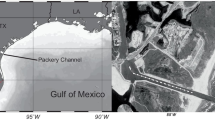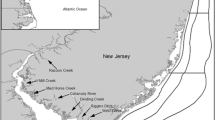Abstract
Few studies have studied the food supply to larval fish in the Irish Sea; thus, we have assessed the full prey-field available to larval fish, ranging from protozoa to copepods. Specifically we assessed if fish larvae feed on protozoa, as suggested by others, and if densities of the protozoa and the appropriate size of metazoan prey were previously underestimated. By examining the gutcontents of fish larvae, the prey available to them, and the potential accessibility of prey to fish, we develop a simple food web, presented as a box-model. By doing so, we indicate that the lack of focus on small metazoa and protozoa has underestimated the food available to fish larvae; without these, we might have concluded that prey levels were too low to support the growth of the larval fish assemblage. Our methods were as follows. Sampling was at two sites, off the Isle of Man, with distinct physical and biological structures, soon after fish spawning: the southwest coast, where many species occur in spring-summer (23 April; 6, 19 May; 1, 22 June; 12 July) and the east coast, where only herring larvae occur in September–November (12, 28 October). Microplankton (15–200 μm), mesozooplankton, and larval fish were collected at 1, 15, and 25 m: microplankton with 1.5 L bottles and a 64 μm-mesh net; mesozooplankton and larval fish with a Gulf VII high-speed sampler (280 μm mesh). The 64 μm mesh net, mounted on the Gulf VII, provided simultaneous hauls. Fixed samples were evaluated to determine species composition, abundance, and biomass. Larval fish diet was determined from fish collected by short net hauls: fixed guts were examined and prey, including protozoa, analysed. Using physical data as a guide, plankton data were integrated through the water column to determine standing stocks. Size-based food availability to larval fish was estimated from the gut contents. The role of protozoa was examined, assuming that they are digested at the same rate as metazoan and if they are digested 2.5–10 times faster; increased digestion rates indicated that they contributed substantially to the larval fish diet.




Similar content being viewed by others
References
Blaxter JHS, Ehrlich KF (1974) Changes in behaviour during starvation of herring and plaice larvae. In: Blaxter JHS (ed) The early life history of fish. Spring-Verlag, Berlin Heidelberg New York, pp575–588
Bowers AB, Williamson DI (1951) Food of larval and early post-larval stages of autumn-spawned herring in Manx waters. Rep Mar Biol Stn Port Erin 63:17–26
Brander KM, Dickson RR (1984) An investigation of the low level of fish production in the Irish Sea. Rapp P -v Réun Cons int Explor Mer 183:234–282
Conway DVP, Tranter PRG, Coombs SH (1993) Digestion of natural food by larval and post-larval turbot Scophthalmus maximus. Mar Ecol Prog Ser 100:221–231
Coombs SH, Nichols JH, Conway DVP, Milligan S, Halliday NC (1992) Food availability for sprat larvae in the Irish Sea. J Mar Biol Assoc UK 72:821–834
Cushing DH (1990) Plankton production and year class strength in fish populations: an update of the match/mismatch hypothesis. Adv Mar Biol 26:249–293
Dickey-Collas M, Gowen RJ, Fox CJ (1996) Distribution of larval and juvenile fish in the western Irish Sea: relationship to phytoplankton, zooplankton biomass and recurrent physical features. Mar Freshwater Res 47:169–181
Edwards ES, Burkill PH (1995) Abundance, biomass and distribution of microzooplankton in the Irish Sea. J Plankton Res 17:771–782
Figueiredo GM (2003) The trophodynamics of the plankton in the coastal areas of the central Irish Sea, with emphasis on fish larvae and their prey. Ph.D. thesis, University of Liverpool, Liverpool
Fortier L, Harris RP (1989) Optimal foraging and density-dependent competition in marine fish larvae. Mar Ecol Prog Ser 51:19–33
Fortier L, Ponton D, Gilbert M (1995) The match/mismatch hypothesis and the feeding success of fish larvae in ice-covered southeastern Hudson Bay. Mar Ecol Prog Ser 120:11–27
Fukami K, Watanabe A, Fujita S, Yamaoka K, Nishijima T (1999) Predation on naked protozoan microzooplankton by fish larvae. Mar Ecol Prog Ser 185:285–291
Gerking SD (1994) Feeding ecology of fish. Academic Press, Inc., San Diego
Govoni JJ, Ortner PB, Al-Yamani F, Hill LC (1986) Selective feeding of spot, Leiostomus xanthurus, and Atlantic croaker, Micropogonias undulatus, larvae in the northern Gulf of Mexico. Mar Ecol Prog Ser 28:175–183
Gowen RJ, McCullough G, Dickey-Collas M, Kleppel GS (1998) Copepod abundance in the western Irish Sea: relationship to physical regime, phytoplankton production and standing stock. J Plankton Res 20:315–330
Gray CA, Kingsford MJ (2003) Variability in thermocline depth and strength, and relationships with vertical distribution of fish larvae and mesozooplankton in dynamic coastal waters. Mar Ecol Prog Ser 247:211–224
Greene CH (1990) A brief review and critique of zooplankton sampling methods: copepodology for the larval ecologist. Ophelia 32:109–113
Hasle GR (1978) The inverted microscope method. In: Sournia A (ed) Phytoplankton Manual. UNESCO, Paris, pp88–96
Hay DE (1981) Effects of capture and fixation on gut contents and body size of Pacific herring larvae. Rapp P-v Réun Cons int Explor Mer 178:395–400
Heath MR (1992) Field investigations of the early life stages of marine fish. Adv Mar Biol 28:1–174
Hopcroft RR, Roff JC, Lombard D (1998) Production of tropical copepods in Kingston Harbour, Jamaica: the importance of small species. Mar Biol 130:593–604
Hunt von Herbing I, Gallager SM (2000) Foraging behaviour in early Atlantic cod larvae (Gadus morhua) feeding on protozoan (Balanion sp.) and a copepod nauplius (Pseudodiaptomus sp.). Mar Biol 136:591–602
Hunt von Herbing I, Gallager SM, Halteman W (2001) Metabolic costs of pursuit and attack in early larval Atlantic cod. Mar Ecol Prog Ser 216:201–212
Jenkins GP (1988) Micro- and fine-scale distribution of microplankton in the feeding environment of larval flounder. Mar Ecol Prog Ser 43:233–244
Kankaala P, Johansson S (1986) The influence of individual variation on length-biomass regressions in three crustacean zooplankton species. J Plankton Res 8:1027–1038
Kiørboe T, Nielsen TG (1994) Regulation of zooplankton biomass and production in a temperate coastal ecosystem. 1. Copepods. Limnol Oceanogr 39:493–507
Kiørboe T, Mohlenberg F, Riisgard HU (1985) in situ feeding rates of planktonic copepods: a comparison of four methods. J Exp Biol Ecol 88:67–81
Knutsen T, Melle W, Calise L (2001) Determining the mass density of marine copepods and their eggs with a critical focus on some of the previously used methods. J Plankton Res 23:859–873
Leggett WC, Deblois E (1994) Recruitment in marine fishes: Is it regulated by starvation and predation in the egg and larval stages? Neth J Sea Res 32:119–134
Leising AW, Franks PJS (1999) Larval Atlantic cod (Gadus morhua) and haddock (Melanogrammus aeglefinus) growth on Georges Bank: a model with temperature, prey size, and turbulence forcing. Can J Fish Aquat Sci 56:25–36
Letcher BH, Rice JA (1997) Prey patchiness and larval fish growth and survival: inferences from an individual-based model. Ecol Model 95:29–43
Lough RG, Mountain DG (1996) Effect of small-scale turbulence on feeding rates of larval cod and haddock in stratified water on Georges Bank. Deep-Sea Res II 43:1745–1772
MacKenzie BR, Leggett WC, Peters RH (1990) Estimating larval fish ingestion rates: can laboratory derived values be reliably extrapolated to the wild? Mar Ecol Prog Ser 67:209–225
May RC (1974) Larval mortality in marine fishes and the critical period concept. In: Blaxter JHS (ed) The early life history of fish. Spring-Verlag, New York, pp3–19
McGurk MD, Paul AJ, Coyle KO, Ziemann DA, Haldorson LJ (1993) Relationships between prey concentration and growth, condition and mortality of Pacific herring, C. pallasi, larvae in an Alaskan subarctic embayment. Can J Fish Aquat Sci 50:163–180
Menden-Deuer S, Lessard EJ (2000) Carbon to volume relationships for dinoflagellates, diatoms and other protist plankton. Limnol Oceanogr 45:569–579
Munk P, Kiørboe T (1985) Feeding behaviour and swimming activity of larval herring (C. harengus) in relation to density of copepod nauplii. Mar Ecol Prog Ser 24:15–21
Munk P, Nielsen TG (1994) Trophodynamics of the plankton community at Dogger bank: Predatory impact by larval fish. J Plankton Res 16:1225–1245
Nagano N, Iwatsuki Y, Kamiyama T, Nakata H (2000) Effects of marine ciliates on survivability of the first-feeding larval surgeonfish, Paracanthurus hepatus: laboratory rearing experiments. Hydrobiologia 432:149–157
Nash RDM, Dickey-Collas M, Milligan SP (1998) Descriptions of the Gulf VII/Pro-net and MAFF/Guildline unencased high-speed plankton samplers. J Plankton Res 20:1915–1926
Nicholas, KR (1995) Secondary production of coastal plankton communities in the western Irish Sea. Ph.D. thesis, University of Liverpool, Liverpool
Nielsen TG, Sabatini M (1996) Role of cyclopoid copepods Oithona spp. in North Sea plankton communities. Mar Ecol Prog Ser 139:79–93
Ohman MD, Theilacker GH, Kaupp SE (1991) Immunochemical detection of predation on ciliate protists by larvae of the northern anchovy (Engraulis mordax). Biol Bull 181:500–504
Owen RW (1989) Microscale and finescale variation of small plankton in coastal and pelagic environments. J Mar Res 47:197–240
Pandian TJ, Vivekanandan E (1985) Energetics of feeding and digestion. In: Tytler P, Calow P (eds) Fish energetics: New perspectives. Croom Helm, Sydney, pp99–124
Pepin P, Penney RW (2000) Feeding by a larval fish community: impact on zooplankton. Mar Ecol Prog Ser 204:199–212
Pingree RD, Griffiths DK (1978) Tidal fronts on the shelf seas around British Isles. J Geophys Res 83:4615–4622
Postel L, Fock H, Hagen W (2000) Biomass and abundance. In: Harris RP, Wiebe PH, Lenz J, Skjoldal HR, Huntley M (eds) Zooplankton methodology manual. Academic Press, London, pp83–191
Prestidge MC, Taylor AH (1995) A modelling investigation of the distribution of stratification and phytoplankton abundance in the Irish Sea. J Plankton Res 17:1397–1420
Sanders RW, Wickham SA (1993) Planktonic protozoa and metazoa: predation, food quality and population control. Mar Microb Food Webs 7:197–223
Sato R, Tanaka Y, Ishimaru T (2001) House production by Oikopleura dioica (Tunicata, Appendicularia) under laboratory conditions. J Plankton Res 23:415–423
Scrope-Howe S, Jones DA (1985) Biological studies in the vicinity of a shallow-sea tidal mixing front v. composition, abundance and distribution of zooplankton in the western Irish Sea, April 1980 to November 1981. Phil Trans R Soc Lond B 310:501–519
Simpson JH, Edelsten DJ, Edwards A, Morris NCG, Tett PB (1979) The Islay front: physical structure and phytoplankton distribution. Estuar Coast Mar Sci 9:713–726
Thompson AB, Harrop RT (1991) Feeding dynamics of fish larvae on copepod in the western Irish Sea, with particular reference to cod Gadus morhua. Mar Ecol Prog Ser 68:213–223
Uitto A, Heiskanen A-S, Lignell R, Autio R, Pajuniemi R (1997) Summer dynamics of the coastal planktonic food web in the northern Baltic Sea. Mar Ecol Prog Ser 151:27–41
Van der Meeren T, Næss T (1993) How does cod (Gadus morhua) cope with variability in feeding conditions during early larval stages? Mar Biol 116:637–647
Acknowledgements
This research was supported by the Conselho Nacional of Desenvolvimento Científico (CNPq/Brazil), which provided Figueiredo GM with a Ph.D. fellowship. We are grateful to the crew of RV “Roagan” who helped in the sampling program and to three anonymous reviewers for helpful comments.
Author information
Authors and Affiliations
Corresponding author
Additional information
Communicated by J. P. Thorpe, Port Erin
Rights and permissions
About this article
Cite this article
de Figueiredo, G.M., Nash, R.D.M. & Montagnes, D.J.S. The role of the generally unrecognised microprey source as food for larval fish in the Irish Sea. Marine Biology 148, 395–404 (2005). https://doi.org/10.1007/s00227-005-0088-0
Received:
Accepted:
Published:
Issue Date:
DOI: https://doi.org/10.1007/s00227-005-0088-0




